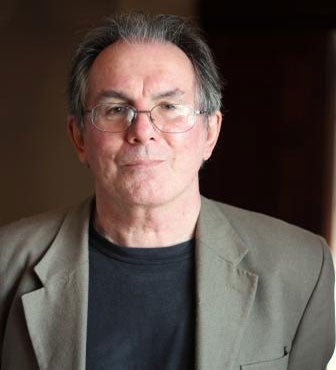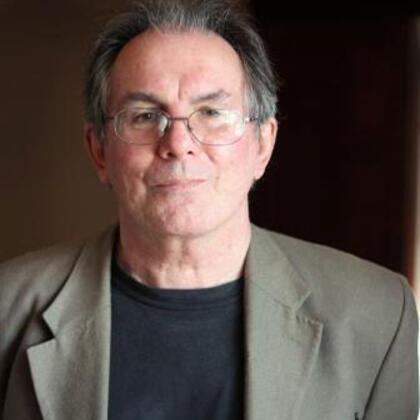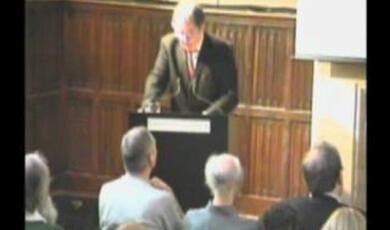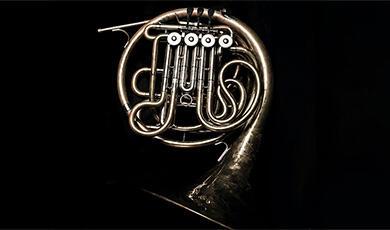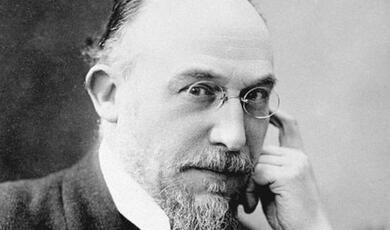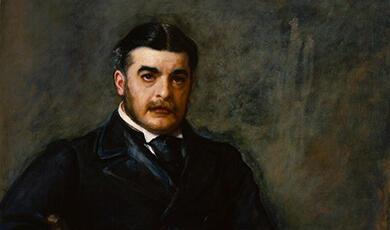Film Music: Opera
Share
- Details
- Text
- Audio
- Downloads
- Extra Reading
What happens when opera meets film? From its earliest days, film has flirted with opera: initially (and perhaps even to the present day) in periodic attempts to gain elite prestige for a medium that has always been associated with popular culture. This lecture will briefly consider some of the ways in which operatic events have been used in film narrative, but mostly it will look at various 'classic' attempts to make opera films, including Ingmar Bergman's The Magic Flute and Francesco Rosi's Carmen.
Download Text
FILM MUSIC: OPERA
Professor Roger Parker
My topic this lunchtime concerns a fraught relationship, one of the longest in film's more than century-long history, and between two unlikely partners. Film and opera have always tended to stare at each other across a divide, a divide assiduously patrolled by border guards of many kinds. I'm referring to emerging gap between elite culture and popular culture, terms that became newly defined and hardened at just the time when films, emphatically at the popular end of the spectrum, began to become public entertainment. From soon after its inception, the film industry made periodic attempts to elevate its status by dabbling in opera. And at the same time opera, increasingly dogged in the twentieth century by its reputation as the most elite of elite cultures, attempted to shake off its burden (not to mention fill its always cavernous and echoing coffers) by exposing itself to film. This was particularly the case during film's earliest, so-called 'silent' era. In 1915, Cecil B DeMille lured Metropolitan Opera star Geraldine Farrar to Hollywood in order to feature her in a film version of Bizet's Carmen, a venture that proved influential enough to spawn a host of other progeny in succeeding years.
Now: those of you of an acutely analytical persuasion will already have noticed that films of operas in the 'silent' era might seem to be confronted by a rather significant obstacle. Geraldine Farrar was doubtless a fine actress and visual presence; but her principal means to impress inCarmen were inevitably vocal ones, and film in 1915 had no way of reproducing them. Instead, she merely acted the role, with live music (presumably relevant bits from the opera) played as accompaniment. ThisCarmen was not, then, exactly a 'silent' opera, but even so it would to us seem a strange affair indeed. There is a nice story (so often repeated that one doubts its veracity) about Farrar seeing an early edit of the film and being so displeased with the way she looked that she leapt up and tried to claw her image from the screen. The tale is of course neatly self-serving: it allows us to laugh or marvel at the naivety of our ancestors, and bask in our own super-sophistication; it tells us how very far we've travelled in developing a tolerance for and understanding of the moving visual image. But Farrar's anger might also remind us of something else: that when opera is put on screen, something vital is going to be lost. That was easy to understand in the very old days, because the missing 'something' was sound; but even in the present-day world of hi-fi opera and hi-tech visual reproduction, seeing and hearing opera onstage and seeing and hearing it on screen are still very different activities.
Let's switch immediately to the present, and to recent DVDs of operas, fast becoming the prime way in which we consume the art form domestically, taking over from video, before which came sound recording, before which came vocal scores and piano scores around which people crowded in the nineteenth century. We twenty-first-century consumers demand so much - and so much that is contradictory. We now seem to prefer our recorded opera to be 'live', with evidence of audience response, sounds of coughing and the clumping of stage feet, and with obligatory establishing shots of the maestro marshalling his musical troops. But the recording must also be visually sophisticated, with as much shot/reverse shot as the music will allow, plus fancy lighting, tracking shots and extreme close-ups. At the sharp end of these new demands are the singers who must also be actors. They have, of course, always sustained this dual role, but operatic acting in the old days (and as recently as fifty years ago) used to be art displayed at a distance: extravagant make-up would be matched by equally extravagant gestures, both of them needed to communicate to the back of a large theatre; movement around the stage would be minimal and deliberate. Productions (stage sets, action, etc.) also tended toward the generic, and for good reason. If the leading tenor caught a cold, you could spirit up another one at three hours' notice, walk him through his movements in thirty minutes, and then launch him toward his destiny. If he happened to have learned the role in a different language, then never mind: opera had, after all, always been foreign. A more serious crisis might be finding those extra yards of material that his costumes would now consume: in the very old days, the best singers would bring their own frocks, and never mind what anyone else was wearing.
None of these old-style operatic manners bothered contemporary film directors very much, as they rarely dreamt of capturing 'live' events. Recall how, half a century ago, film viewers were comfortable with extreme dissociation between the filmic and the operatic worlds. In the 1953 screen version of Aida, directed by the aptly named Clemente Fracassi (fracasso means 'loud noise' in Italian), Verdi's opera is given a radical filmic makeover. We see nothing of the singers who provide the soundtrack (a stellar cast led by Renata Tebaldi); instead, film icons of the day gesture their way through the plot, often hardly opening their mouths even for the sustained high notes, and thus making little attempt to suggest that real singing is heavy work, likely to result in bulging neck and heaving chest. Sophia Loren blacks up decorously as Aida (and if that sounds implausible, the reference sites tell us that Gina Lollobrigida was also considered for the role), and she certainly possessed a famously heaving chest (as she once, memorably said, 'Everything you see, I owe to spaghetti'). But her high B-flats emerge as if produced by the fairies.
I can't resist playing you an excerpt from this little-known film, whose main difference from the Ben Hur model was that its visual budget was almost laughably restricted and whose 'desert' sets often look as though they've been recycled from old Lone Ranger episodes. A good flavour comes from the first scene in Act 2, in which (as the deep-voiced commentator tells us) Amneris, played by a young Lois Maxwell, long before she came to fame as Miss Moneypenny in the early Bond movies, confronts Aida jealously. There is so much to treasure here: in the super-decorous yet attention-seeking bathing sequence; in the shocking bad taste of the Dance of Moorish slaves, whose protagonists seem to have fashioned their costumes from the undergarments of the local rugby team, and whose skipping-rope routine looks like the last resort of a desperate choreographer; and of course in the exchange between Maxwell and Loren, who nonchalantly (albeit with impressive accuracy) lip-sync the terrific singing of Ebe Stignani and Renata Tebaldi.
PLAY AIDA (FRACASSI, 1953), CHAPTER 4 (START TO 36:58)
No, they certainly don't make them like that any more, and probably most of us will be relieved that they don't. However, if you watch the film all the way through, something significant happens: you begin to adapt to the codes and eventually you may even become caught up in this strangely divided performance. The excellence of the singing and the filmic ease of the actors seem somehow to merge in your imagination. Just as we always have to in opera, we enter a strange new world and accept its conventions.
But the first impression on seeing a filmed opera such as that of Aida is to be aware of how times have changed. To cut a plausible figure in today's 'live' opera DVDs the stars need to be singers (which means, lest we forget, jobbing musicians) and stage actors and film actors; they need, if you will, to be Renata Tebaldi and Sophia Loren. Some have indeed become remarkably comfortable with the camera, and can even (lighting is of the essence here) look believably filmic when singing strenuous, nineteenth- and twentieth-century roles: roles written for musicians who can produce sounds loud enough to ride over a large, brassy orchestra and fill a theatre housing thousands of spectators. All these things might seem unambiguous advances on Cecil B. DeMille's Carmen or Clemente Fracassi's Aida; but on the other hand many modern singers struggle entirely to satisfy their new, multiple masters. They have bodies similar to the ones most of us inhabit, which means not remotely within hail of the Hollywood ideal; they are constrained to open their mouths very wide; under the heat of the lights they pant and sweat with the effort; their eyes dart to the conductor at key moments (remember, they're musicians). It is, in this context, remarkable that they manage to communicate to us visually with such effect. But of course we spectators have also adapted: we have learned to tolerate, perhaps even be moved by, their evident signs of strain, the marks of their labour. At a time when our lives are ever more saturated with virtual representations of the operatic object (indeed of every other object), we have thoroughly absorbed the new codes that have allowed opera 'live' on DVD to become fashionable.
That word 'live' deserves some further attention. Most modern opera DVDs make some show of telling us that they present stage events rather than studio confections. Audience chatter and then its sudden hush are now a clichéd lead-in to the start of acts, as are dimming lights and the conductor's entrance and raised baton. It is, then, doubly important to remind ourselves that the sounds we hear and the spectacle we witness on such a DVD (or indeed any filmed version) are very far from those we would experience in the theatre, and this no matter which seat in the house we might occupy. To name just two of the most obvious differences: first, on a DVD the various layers of sound are recorded and then mixed in ways that radically alter the balance amongst them, in particular that between the singers and the orchestra; and, second, DVD watchers continually see the stage from impossible angles and often in impossibly close detail, and they are of course continually constrained to follow the camera's gaze. That any sense of 'being there' is maintained is mostly due to our infinitely flexible suspension of disbelief: our ability to absorb the codes.
This much is obvious to anyone who watches opera both on DVD and in the theatre. But one of its corollaries is less often made explicit: namely that critiques of musical performance or production details as seen on DVD are just that and no more. To discuss critically a 'live' opera DVD should not, in other words, be assumed to offer a convenient, unproblematic, home-based way of critiquing the production it records. It would, after all, be perfectly possible for the same viewer to come to different, even contradictory conclusions about both the musical and visual aspects of a production, were she or he to migrate from recorded viewing to live viewing: were, for example, her ears attuned to a new sonic balances; or were his eyes no longer enslaved by the director's constantly roving gaze.
In musical matters the differences, potentially crucial, will be clear to even occasional opera-goers. What tends to be erased in recordings is an aspect of vocal performance that is often critically important in the theatre: the ability of a voice to carry, to maintain its focus across distance. On a recording, everyone tends to be equally audible: to have, if you will, equal vocal presence. What is more, this lack of presence on the recording, and the fact that voices and orchestra are separately recorded and then artificially blended together, makes us more aware of tuning discrepancies between them, and also less tolerant of minor lapses in ensemble. For this and many other reasons, a recorded opera needs to be more musically disciplined to have its effect; in the theatre, though, striving for such discipline often brings with it caution - and caution can be the enemy of theatrical communication.
Similar problems exist on the visual level. As already mentioned, there are ways in which good live-theatrical performance may be antithetical to the demands of film. What makes them so compelling on stage - 'big' eyes, expressive hand movements, delicately timed gestural exaggerations - can come across as horribly melodramatic when viewed in close-up. On the other hand, comparatively phlegmatic stage presences (and there are plenty of those on plenty of operatic stages) can sometimes grow in stature as they are reduced to screen size and are gazed at minutely. More important, though, is the way in which the production itself can lose or gain when transferring to the screen. Again it's partly a question of presence. What clearly migrates least well to the small screen are grand scenic revelations: transformational moments, for example, in which spaces are suddenly opened up. What works best are small narrative devices: telling recurrences of significant objects that can enjoy the odd close-up; or clearly decodable stage gestures that can be easily captured and framed.
There's a moral in all this, one worth bearing in mind. It is clear, indeed a commonplace, that the medium of DVD has textualized opera anew, just as video did before it, and film before that, and sound recording before that. By recording the event and making the result repeatable, these media have progressively enabled ever more elaborate critical responses to operatic performance. But at the same time they have progressively encouraged concentration on certain aspects - those they transmit most successfully - at the expense of others. This situation is exacerbated by the fact that those areas of operatic performance most difficult to address in words - what I described a moment ago as the 'presence-effect' of vocal performance or of the visual system - are precisely those that can't be recorded or reproduced. There is, in other words, a way in which 'live' opera DVDs enable a delusion: the delusion that when we analyze them, we are addressing 'opera in performance'.
Let's take this a little further by looking at a scene from a recent (2005) DVD of Verdi's opera Don Carlo, directed by Willy Decker and starring Rolando Villazón and Amanda Roocroft. In this production, the looming presence of a violent, interdicting religion is symbolically represented from time to time by the appearance of an enormous crucified Christ toward the back of the stage. This figure is so large that we can only see the feet (nailed bloodily together) and part of the legs. It appears for the final time at the start of the last act: as Elisabetta (Roocroft) sings 'Tu che le vanità' the feet, well, loom there at the back. At least, one assumes they did so for those attending the theatre. On the DVD, though, their presence is anything but continuous. This aria famously involves an intricate and complex dialogue between the orchestra and the soloist, the former's interjections often seeming to prompt the latter to new thoughts, particularly reminiscences of past moments. The video director, Misjel Vermeiren, though, gratefully accepts each orchestral interjection as an invitation to take us away from a close-up on Elisabetta and to re-establish the full stage. The result is that, five times during the aria, those huge feet suddenly reappear on screen, and do so at musical/verbal moments that are in some cases so inappropriate as to seem risible. They are no longer a looming, continuous presence, hovering over the entire scene, but an occasional visual eruption, and one coinciding with moments of musical change that might seem to herald quite other departures. Let's hear part of the aria, which also gives us a chance to look at Roocroft: she is I think a good example of a compelling stage actor who seems exaggerated in the intimacy of a DVD.
PLAY DON CARLO (OPUS ARTE, 2005), CHAPTER 17 (START TO 59:08)
So: after those two extreme examples, of the rather old and the very new, one might conclude that any kind of film of an opera is going to be tricky in some way; and of course that's exactly the case. There are obvious points of tension that we've already seen: the fact that the people who sing opera are rarely similar to the people who usually star on screen; and that they are doubly hampered by having to perform strenuous physical tasks. You can hide them, as in Aida, or show them, as in Don Carlos, but both strategies cause problems. More basic still, though, is the issue we came across most obviously in the Don Carlosexample: of what the camera is supposed to do in all those leisurely frozen moments that opera is so famous for; of whether or not it should obey the rhythms of the music, and so on. In this context we might recall that films of operas have a highly unusual relationship between sound and visuals, for the simple reason that the sound element is fixed: the camera must dance to a fixed tune.
In what remains of this talk, I want to turn to two filmed operas made in the years between Aida and Don Carlos, both of them by established (indeed, extremely distinguished) film directors, and both attempting something original: a new amalgam, if you will, of film culture and operatic culture. The first was made in 1975, and its augurs were not good. Ingmar Bergman was and is known as a notoriously 'difficult' modern film director, but in the mid 1970s he decided to offer the world a very personal version of Mozart's The Magic Flute. Those who had foundCries and Whispers and other expressions of Nordic angst less than relaxing feared for the worst. Nor were their doubts allayed by hearing that, as a first step, Bergman had decided to alter the plot (and even the order of scenes) so as to make it chime better with his particular obsessions: the opera becomes, to be brief, a notably Bergamesque scene of family trauma, with Pamina at the centre of a custody struggle between estranged parents Sarastro and the Queen of the Night. What's more, the commission came from Swedish TV, and so we don't get Die Zauberflöte but Trollflöjten, an opera sung and spoken in Swedish, and with singers of (mostly) less than international calibre.
All this mattered not a jot. When the film went on general release it quickly gained a reputation as one of the best of all operatic films: a small masterpiece that can tell us a great deal not only about Mozart's opera, but about the whole business of what film can contribute to the operatic medium. Perhaps its most important quality is the persistence with which it confronts and makes inventive capital out of the central problem of all filmed opera: of what happens when a live event is manipulated and then frozen on film. To make the point immediately, Bergman mostly restricts the action within a theatrical space (a recreation of the Drottningholm theatre near Stockholm, the original having been judged too fragile to use), but is constantly sneaking backstage or into the auditorium. During the interval between Act 1 and 2, for example, we see the various singers explore their characters in the modern world: Sarastro quietly readsParsifal; the Queen defies clearly-posted backstage regulations by drawing greedily on a cigarette; the dragon wanders forlornly by; Tamino and Pamina play a silent game of chess. Even more surprising, though, is the Overture, in which close-ups of an imagined theatre audience are counterpointed against the rhythms of the orchestra, creating a kind of dance between Bergman's editing and Mozart's music. Notice in particular that there is nothing at all routine about this music-camera dance: Mozart's rhythms are sometimes echoed and sometimes contradicted by the editing, just as the recurrences of faces to create structures and symmetries are equally eclectic.
PLAY THE MAGIC FLUTE (BERGMAN, 1975), CHAPTER 1 (FROM 1:20 TO 5:20)
As that excerpt perhaps makes clear, the greatest glory of this film is the way in which the camera and lighting constantly respond to and set themselves in dialogue with the words and the music. Tamino's first aria, in which he gazes at a portrait of Pamina, falls in love and resolves to rescue her, is a classic case. His text describes the beginning of a classic Enlightenment quest, and the music elegantly plays out its own tonal and thematic 'quest' or 'argument'; and, in counterpoint with this, Bergman's camera embarks on a journey, one in which the constantly changing play of light and angles on Tamino's face (literally, his gathering 'enlightenment') is in dialogue with the portrait he holdsa - portrait that comes to life as if by magic, subtly reminding us that even the camera's gaze can sometimes be subverted. In contrast to the modern-day DVD ofDon Carlos, with its routine exchanges of close-up and full-stage views, this concentration on a close-up shot of the singer (something of course set up by the Overture) a much more daring technique: one perhaps only possible in the comparatively controlled atmosphere of the film studio, but one that seems to add layers of meaning to this already dense and minutely structured piece of musical theatre.
PLAY THE MAGIC FLUTE (BERGMAN, 1975), CHAPTER 4 (START TO 23:02)
My last opera film comes from nine years after Bergman's Flute, and returns us to were we started, with a screen version of Carmen. This one was made in 1984 by the celebrated Italian director Francesco Rosi, and stars Plácido Domingo and Julia Migenes-Johnson as José and Carmen. During the previous twenty and more years, Rosi had become known as one of the most successful directors of politically-engaged cinema, and won international recognition for such quasi-documentary films as Il caso Mattei in 1972 and Cadaveri eccellenti in 1976, in which Italy's entangled postwar history of organized crime, terrorism and politics is sometimes brutally exposed. Again, this might seem unpromising preparation for an operatic adventure, and most admirers of his early work have seen hisCarmen as a sad decline into sentimentality. However, as with Bergman'sFlute, hindsight has judged this film as among the most innovative in its approach to the operatic object. In Rosi's case, there is no play with the theatre: his is unambiguously a film version, and that is indeed the point. The principal innovation comes from the manner in which he creates a tension between two starkly contrasting worlds, one of them drawing deeply on his background in realist cinema, the other frankly artificial and quasi-theatrical. Rosi then uses these contrasting languages to articulate the two main strands of the opera: the 'filmic' world is consistently attached to Carmen and her bohemian entourage of gypsies, smugglers and bullfighters, while the stiffer, more conventional world of José and his girl-back-home Micaëla inhabit the artificial, theatrical spaces.
A wonderful example of how this works in practice comes in the José-Micaëla duet in Act 1, in which Micaëla brings a message from home to José, who has already had his first encounter with Carmen, and find reassurance and calm in this reminiscence of the security of home comforts. But Rosi wants constantly to undercut this exchange, reminding us that its world is fragile and will soon be broken, and he does so by regularly drawing attention to its artificiality. The duet begins, for example, with the two soloists very much in the background, divided from the viewers by a scene very much from the 'realistic' side of the 'Carmen' world, an untidy village, with animals and children and lots of chaotic action. But the artificiality of the duet is also emphasized by the fact that the soundtrack features the singers in close focusa - quite improbable closeness given their distance in the shot, and made more so by the fact that they move still further away. Notice also the occasional ambient, realistic noise from the 'film' world, and also the elderly man who wanders slowly towards the camera at the start. This man has appeared in the previous scene, and there he was something of a portent, leading the villagers to Carmen. Here he busies himself in the 'real' world, but several times he turns towards José and Micaëla, looking at them with some curiosity, as if to say 'why on earth are those two singing at each other?' Then, as the duet settles into its main movement, we suddenly move to a close-up of José and Micaëla, posed facing each other seated on a log, with classical and highly artificial symmetry, Domingo adding to the awkwardness by seeming a little constrained by his impressively striped but rather tight military trousers.
PLAY CARMEN (ROSI, 1984), CHAPTER 8 (START TO 32:08)
The end of the duet is even more daring. As the final musical section begins the couple have risen from their log and begin to walk together arm in arm. At first the camera follows them, but after a short while, it stops and they continue, ever onwards, getting more and more into the distance. This is just the moment at which their duet reaches the 'warbling' stage (one of the most conventionally operatic moments in Bizet's entire score), and again their vocal proximity is markedly, even comically as odds with their gradual visual retreat. And at the last something extraordinary happens. Down the road on which they are retreating comes, as if on a collision course, a man riding a hugely overladen horse. Man and horse eventually obscure completely the duetting couple, their vocalizations are all but drowned by the ambient noise of the horse's hooves, and a view of their final cadences is partially obscured by the dust that has arisen.
PLAY CARMEN (ROSI, 1984), CHAPTER 8 (36:55 TO 38:35)
Our brief time with operatic films is coming to an end and as usual there are many more points that could be made and many more examples that could be discussed. In particular, there are a host of broader considerations about various changes in technology that I have hardly touched upon: we now tend to watch all these moving images by way of DVD, and soon that format will probably become obsolete, superseded by internet-connected computers. (As I'm sure many of you know, the amount of operatic material available on the internet through outlets such as youtube is already amazing, constituting a visual archive that could only have been dreamt of a decade ago.) But these new media are not the same as predecessors such as video and film; and its vastly enlarged navigational capabilities, its use of 'chapters' and freeze-frames and the rest, may well influence viewing practices as well as directorial attitudes. But there is a larger point with which I'd like to close. As I'm sure many of you know, the huge success of the Metropolitan's 'live HD' cinema broadcasts of the last couple of years have been imitated by a host of companies around the globe, including some in this country; what is more, the opera sound-recording industry has all-but dried up, mostly to be replaced by 'live on DVD' format. It looks, in other words, as if we're going to see a great deal more filmed opera in the years to come. This may in all sorts of ways be a positive development; but it should at least come with reminders. If we watch films of opera rather than attending live performances, and almost all opera-lovers are constrained to do this at least some of the time, there is a chance - particularly at the hands of directors keen to encourage our suspension of disbelief - that we will begin to confuse the two experiences. Of course, we may well confuse them pleasurably, and thus contribute to our sum of operatic enjoyment. But an awareness of what is lost and what can be gained when we forsake theatrical absorption or alienation and instead gaze at opera on film may also sharpen our critical attitudes, and perhaps because of that sharpen the gratification we take in both activities.
©Professor Roger Parker, Gresham College, 11 February 2009
Part of:
This event was on Wed, 11 Feb 2009
Support Gresham
Gresham College has offered an outstanding education to the public free of charge for over 400 years. Today, Gresham College plays an important role in fostering a love of learning and a greater understanding of ourselves and the world around us. Your donation will help to widen our reach and to broaden our audience, allowing more people to benefit from a high-quality education from some of the brightest minds.


 Login
Login
